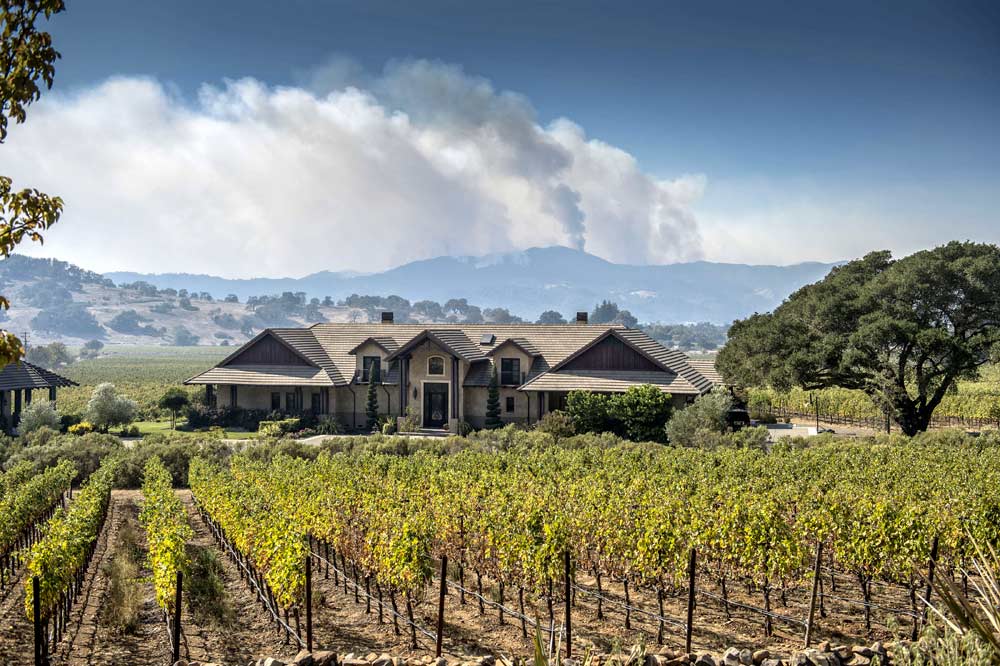
The Nun Fire, one of Central California’s infamous 2017 blazes, burns on Sugarloaf Ridge with Harbison Estate Winery in the foreground in Oakville. In spite of the blue skies, a vineyard owner in a situation like this should probably talk to an insurance agent about starting the smoke taint coverage process. Even though a vineyard may escape flames, smoke taint might not show up in wine until months later. (Hector Amezcua/Sacramento Bee)
Wine grape growers should keep insurance in mind if they see smoke on the horizon this year.
In the wake of California’s fiery 2017, insurance companies saw a rise in claims of smoke taint, when smoke affects the flavor of wine and therefore the value of wine grapes delivered to the winery.
Insurance programs cover smoke taint under the rules of the U.S. Department of Agriculture’s Risk Management Agency, or RMA, but only with a timely claim, experts warned. The problem is that smoke taint may not manifest for months after harvest and growers wouldn’t even know until the winery either rejected their grapes or reduced their payment.
“They (growers) may not have found out until February that they had smoke taint,” said Greg Merrill, executive vice president of Pan American Insurance Services of Fresno, California.
Merrill and other insurance experts advise wine grape growers to file claims, even if they don’t end up needing them in the long run. Crop insurance is not like car insurance, he said. Growers won’t be penalized, and they won’t lose coverage just because of a claim.
Technically, RMA guidelines ask growers to report a notice of loss within 72 hours of whatever event caused the damage, such as, say, smoke from nearby fires blowing across maturing vineyards, Lacey Menasco, an RMA risk management specialist in Spokane, Washington, told growers at the Washington Grape Society’s 2017 annual meeting in December.
“I suggest you submit a notice of loss right away,” she said.
The final deadline is 60 days after harvest, Merrill said. “Beyond that the insurance agency is required to shut it down,” he said.
Either way, growers must begin the insurance process before they know for sure if they have smoke taint.
They also must prove smoke taint through an independent laboratory, and they must start that process before harvest, too.
The lab will screen for elevated levels of guaiacol and 4-methylguaiacol, chemical markers most commonly associated with smoke, according to the California Association of Winegrape Growers.
The RMA has updated its guidelines for those tests in the wake of the 2017 fires. Previously, the agency required 24.8 micrograms of each chemical as a threshold; now they just require an “elevated level.”
The growers also need a rejection letter from the winery stating the reason for rejection or price reduction. They also must collect samples of 200 berries per variety from the vineyard in question before harvest. Test results received after harvest are acceptable, but the grape samples must have been collected before harvest.
Meanwhile, researchers are looking for more clues about how smoke affects wine and how to mitigate the effects. “There’s still a lot to learn about smoke taint,” said John Aguirre, president of California Association of Winegrape Growers. (See “Tainted results should be helpful” story below.)
For now, the insurance lesson is to communicate early with an agent, even if smoke is just wafting on the horizon, Merrill said. Don’t wait to find out for sure. “If you were to picture your ideal growing season, … picture that and then at any time during 2018 it deviates from ideal, you have a potential for damage.” •
—by Ross Courtney
Tainted results should be helpful: Researchers unexpectedly study smoke’s impact on grapes during real-world conditions.
The wildfire smoke that settled over Central Washington late last summer gave researchers studying the effects of smoke taint on wine grapes the perfect chance to examine the impact in real-world conditions.

Tom Collins
The smoke experiment equipment set up in Washington State University’s research vineyards — in anticipation of controlled smoke trials — ended up capturing data on smoke particulate levels in the air during real-life smoke events in mid-August and early September, said Tom Collins, assistant professor at WSU’s Wine Science Center in Richland, Washington.
In mid-August, smoke from large wildfires in British Columbia settled over much of Central Washington for almost two weeks, but the collective impact on grapes was negligible. “The air quality definitely looked poor but the particulate matter was not that high,” Collins said at the Washington Winegrowers annual convention in February.
Levels of tiny air pollution particles known as PM 2.5 averaged about 0.2 milligrams per meter, while “in our smoke trials, to deliberately get grapes that are affected, we’re using around 1 to 1.5 milligrams per meter,” Collins said. No chemical markers indicating smoke taint were found in exposed fruit, which was preveraison during the smoke event.
But a few weeks later, as wildfires raged in the Columbia Gorge and the Central Washington Cascades, smoke levels in the vineyard approached 1 mg/m3 and grapes were starting to ripen, increasing their susceptibility, Collins said.
“That second exposure, depending on where you were, there are wines that definitely could be affected,” he told the Washington Wine Commission in January, which funds his research.
Some of the fruit Collins collected after the September smoke contained guaiacol and 4-methylguaiacol, compounds derived from burning wood that indicate smoke exposure. These are the common tools for assessing exposure, but his research suggests that their presence doesn’t predictably translate into perceptions of smoky flavors in wine.
“There are wines with high levels that taste OK and wines with low levels that taste tainted,” he said.
Measuring smoke taint is complicated because the smoke compounds bind to sugars to form glycosides, which have no aromas until they break down over time in the wine, releasing smoke compounds wine drinkers notice. How wine chemistry changes as it ferments alters the final expression as well.
That’s why Collins has also put a call out to Washington and California wineries this winter to share tainted wines, so he can measure both the chemical composition and the perception of off flavors to find out what really constitutes a taint problem.
Collins also plans to continue his research to expose ripening grapes to smoke at different levels for different time periods to see what puts the fruit at greatest risk and to maintain a supply of tainted grapes for lab experiments to see how the wine-making process can mitigate the damage of smoke exposure.
“We can’t rely on natural wildfires to give us research material every year,” he said. •
—by Kate Prengaman






Leave A Comment